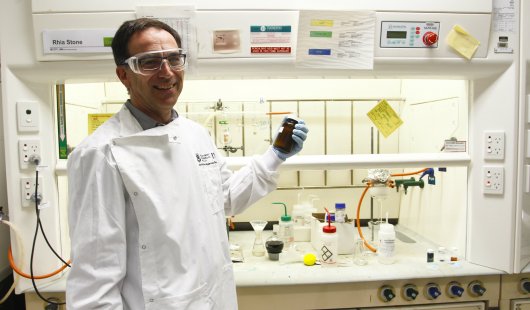Supercharged antibiotics could turn tide against superbugs
An old drug supercharged by CO-ADD researchers at The University of Queensland has emerged as a new antibiotic that could destroy some of the world’s most dangerous superbugs. The research was published in the journal Nature Communications.
The supercharge technique, led by Dr Mark Blaskovich and Professor Matt Cooper from UQ’s Institute for Molecular Bioscience (IMB), potentially could revitalise other antibiotics.
Antibiotic-resistant bacteria – superbugs – cause 700,000 deaths worldwide each year, and a UK government review has predicted this could rise to 10 million by 2050.

CO-ADD Program Coordinator: Hit Validation and Chemistry, Dr Mark Blaskovich
Dr Blaskovich said the old drug, vancomycin, was still widely used to treat extremely dangerous bacterial infections, but bacteria were becoming increasingly resistant to it.
“The rise of vancomycin-resistant bacteria, and the number of patients dying from resistant infections that cannot be successfully treated, stimulated our team to look at ways to revitalise old antibiotics,” Dr Blaskovich said.
“We did this by modifying vancomycin’s membrane-binding properties to selectively bind to bacterial membranes rather than those of human cells, creating a series of supercharged vancomycin derivatives called vancapticins.”
The rebooted vancomycin has the potential to treat methicillin-resistant Staphylococcus aureus (MRSA) and vancomycin-resistant Enterococci (VRE).
Professor Cooper said pharmaceutical companies had departed the antibiotic discovery field because new antibiotics were difficult to find and were not as lucrative as cholesterol-lowering medications or cancer treatments.
“Hence many scientists are re-engineering existing drugs to overcome bacterial resistance, rather than searching for new drugs,” he said.
“Drug development is normally focused on improving binding to a biological target, and rarely focuses on assessing membrane-binding properties.
“This approach worked with the vancapticins, and the question now is whether it can be used to revitalise other antibiotics that have lost effectiveness against resistant bacteria.
“Given the alarming rise of multi-drug resistant bacteria and the length of time it takes to develop a new antibiotic, we need to look at any solution that could fix the antibiotic drug discovery pipeline now,” Professor Cooper said.
The research, published in the journal Nature Communications, was supported by the Wellcome Trust, the world’s largest biomedical charity, and Australia’s National Health and Medical Research Council (NHMRC).
MEDIA COVERAGE
The publication was also highlighted in a Nature 'Behind the Paper' blog post, Infectious Disease Hub blog post and Australia's Channel 10 News
Whilst we are focused on the overuse of antibiotics driving resistant, it is important to remember that many disadvantaged people in the world don’t have access to any #antibiotics. @CooperGroupIMB inspired antibiotic #drugdiscovery @nature blog post #AMR https://t.co/TiU00Dnmhf pic.twitter.com/Ygk8x2vsXm
— CO-ADD Antibiotics (@COADD_news) January 16, 2018
Brisbane based researchers have re-engineered an old drug that might be the new weapon in the fight against superbugs. #TenNews @kcostalos pic.twitter.com/yDmuo1fYIF
— TEN Eyewitness News (@channeltennews) January 12, 2018
Supercharged #vancomycin to the rescue – @mark_blaskovich speaks about his #research into an important new Gram+ve #antibiotic https://t.co/WkC6p9vxl5 #AMR #drugdiscovery #AntibioticResistance
— Infectious Diseases (@IDHubFSG) January 4, 2018
